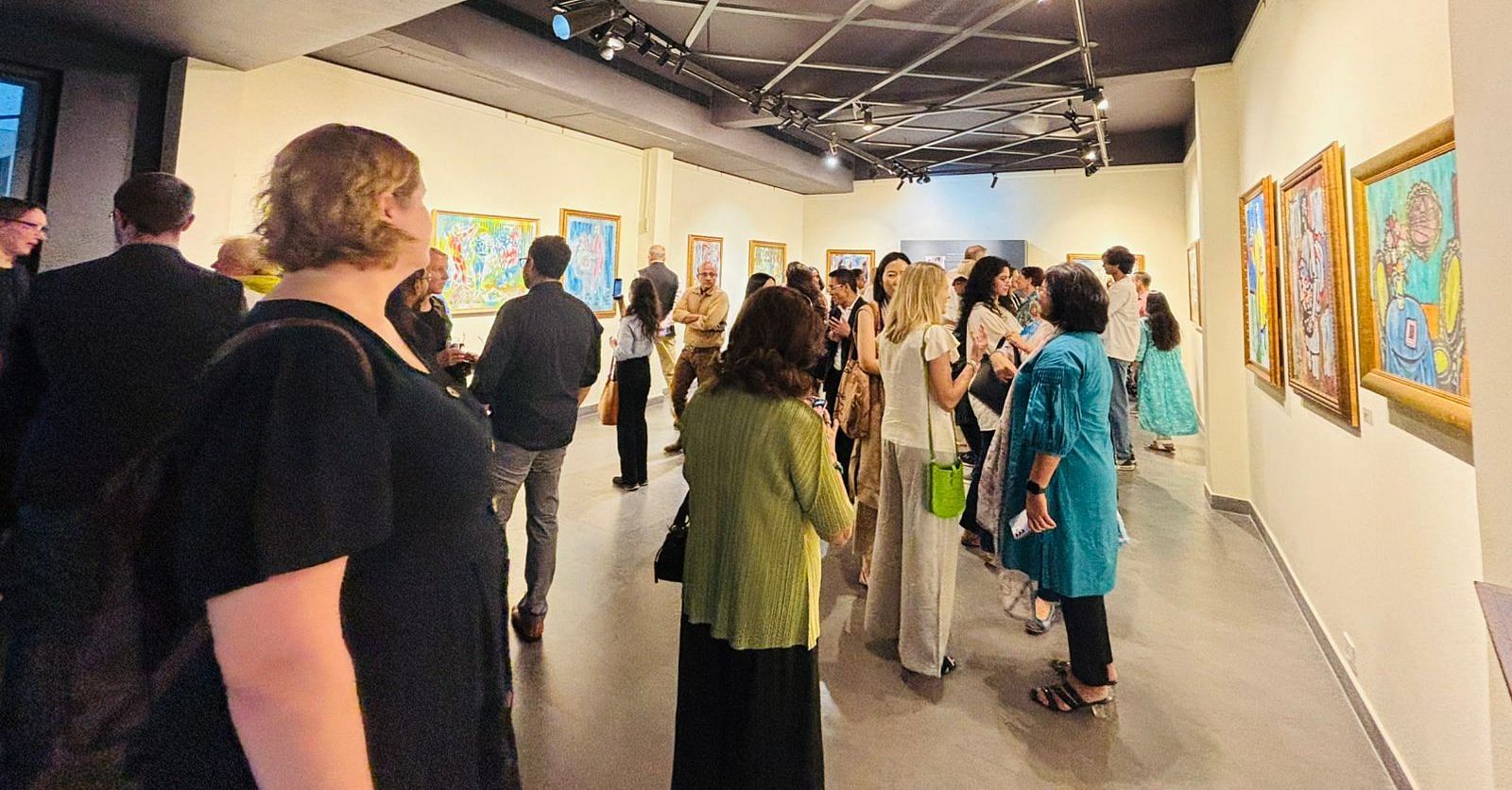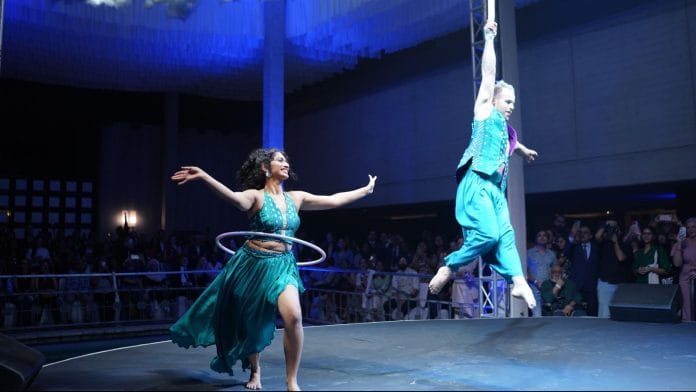New Delhi: The embassies in Delhi are on a cultural overdrive. It’s no longer just about trade and strategic partnerships.
In the run-up to Diwali, diplomatic circles in Lutyens’ Delhi lit up. One evening at the Swiss Embassy, two dancers—one Indian, one Swiss—intertwined mid-air with the song Kajra Re playing in the background, as the who’s who of Delhi watched spellbound. A few days earlier, a Nordic band made its debut performance outside its homeland at the Norwegian Embassy before heading to Jodhpur for a folk music festival. A week after, the Austrian Embassy hosted a reception ball.
The festive season and pleasant weather aren’t the only reasons behind this flurry of activity. Smaller, newer, and more dynamic embassies and high commissions have cracked the code to visibility in India: cultural diplomacy.
Until now, cultural diplomacy was India’s tool to project its soft power abroad—Bollywood and Yoga. But since Prime Minister Narendra Modi came to power, it has become the best and easiest way for smaller nations to build connections with New Delhi.
With major players currently engaged in ‘hard’ diplomacy—amid two wars and a host of trade agreements—smaller embassies are rushing to fill the gaps with soft diplomacy. They’re showcasing linguistic ties, shared heritage, movement of people, and ancient trade and crafts.
No stone is left unturned. It’s no longer just about yoga, Ayurveda, or study-abroad programmes. Embassies are hosting film festivals, art exhibitions, concerts, and food tastings. High commissions are publishing everything from comic books to dictionaries. Ambassadors are posting dance videos on Reels and TikTok; the South Korean and German embassies even performed to Naatu Naatu.

“One may feel it’s a matter of arrogance,” said Vinay Sahasrabuddhe, former MP and president of the Indian Council for Cultural Relations (ICCR). “But it’s a fact of life that the colourfulness of Indian culture, the variety of manifestations of it, and its sound philosophical base has the potential of attracting the global community — which is exactly what has happened.”
This cultural exchange is mutual. As India flexes its cultural muscle abroad, foreign embassies in India are reciprocating in kind.
“Their assertion in a way is to highlight and exhibit the nuances of their culture—more so in India, because India is the right ensemble of cultural preservation,” said Sahasrabuddhe. “We have retained our identity and therefore people are more keen to tell India about themselves,” he added.
Also read: India must tap into its cultural economy to become a global power
From Sanskrit to satellites
Lithuanian Ambassador Diana Mickeviciene is one of Delhi’s most visible diplomats, involved in various cultural events. As a student, she spent time in India. As ambassador, she is highlighting similarities between India and Lithuania.
She is helping build close diplomatic ties from scratch: Lithuania established its embassy in Delhi in 2008 and India only reciprocated in Lithuania in 2023.
Mickeviciene and the Embassy of Lithuania put a spin on cultural diplomacy by hosting a lecture series with the Ministry of External Affairs. The theme: similarities between Lithuanian and Sanskrit.
“History hasn’t been kind to either India or Lithuania,” Mickeviciene said at the embassy in Vasant Vihar. “Every nation needs a connector. I thought we should take our centuries-old ties back to its starting point, which is the civilisational and linguistic connection.”
In Lithuania, the similarities between the two languages are well-known, so this linguistic connection wasn’t exactly news to Lithuanians. MK Gandhi occupies an esteemed place in Lithuanian history, with former ambassadors publishing books on Indo-Lithuanian connections, such as India & Lithuania — a Personal Bond (2016). In 2021, her embassy even published a comic book chronicling the lives and experiences of the first Lithuanians who travelled to India in the 16th century.
But this connection with Lithuania was certainly news to many Indians.
Highlighting these cultural ties has paid off: Lithuania was mentioned by Modi in his ‘Mann Ki Baat’ radio address in August and described as a friend, putting the small Baltic nation in the Indian spotlight.
“Friends, this audio is connected with a European country, Lithuania. Vytis Vidunas, a professor there, has embarked upon a unique endeavour… He has named it Sanskrit on Rivers,” said Modi, before explaining that Vidunas recites the Vedas and the Bhagavad Gita on the banks of the River Neris.
Suddenly, an “unknown place” became known to India, pointed out Mickeviciene.
Also read: Singing in each other’s tongue—Buhe Bariyan in Beijing echoes China-Pakistan friendship
Culture in action
The key to the Indian heart, it seems, is civilisational and linguistic ties: unlock a shared history, and the cup runneth over.
A good example is The Long Night of Literature—an annual European festival in New Delhi where writers hold classes and readings, usually in their native language.
In 2024, Spain’s group of writers included Sameer Rawal, whose work is available in four languages — Hindi, English, Spanish, and Catalan. Rawal has taught Hindi in Barcelona and Catalan in Delhi.
Film is another medium that serves as a cultural bridge, although ‘serious’ cinema might not draw the audience like typical Indian masala films. But countries are still finding ways to marry the two and tap into the large Indian viewership.
The Australian High Commission has been highlighting the role of Indian diaspora—its second-largest—in Australia. Television show Four Years Later, an Australian production about the Indian immigrant experience, was recently screened at the Australian Embassy in Delhi. Another film was shown at the MAMI Mumbai Film Festival, while Australian musicians have participated in jazz festivals in India. Australia was also nominated as the ‘Country of Focus’ at the International Film Festival of India (IFFI) this year.
“Culture brings general visibility but its main role is to open up horizons for other interactions,” said Mickeviciene, explaining that Lithuania has a lot more to offer the Indian market, including nanosatellites, lasers, and hi-tech government solutions. “Our relationship spans everything—from Sanskrit to satellites to semiconductors. Culture is one way to highlight this.”
Also read: Embassies in Delhi flexing soft power, appealing to Indians’ taste buds—ratatouille to kimbap
Old stories, new connections
Finland, Sweden, Romania, Luxembourg, the Netherlands, Latvia, Cyprus, Ireland, Malta, Austria, Denmark, Hungary, Bulgaria—all these countries are screening their films at the 29th European Union Film Festival in New Delhi that ends on 16 November.
Smaller European countries are aiming to showcase their cultures beyond the shadow of giants like France, Italy, Greece, and Germany. The Czech Embassy, for instance, wants Indians to learn about Czech literature as well; it adapted Franz Kafka’s The Trial as a Hindi play—Giraftari.
New Delhi hosts more diplomatic missions than most cities outside of Europe and the US—ranking just behind Jakarta and ahead of cities like Tokyo, Beijing, Berlin, Moscow, Seoul, Bangkok, and Cairo.
India’s global footprint is expanding to reach these countries as well—it has opened new diplomatic missions across Africa (with 16 embassies) and Latin America (two embassies), reflecting its commitment to a multipolar world order.
But this is offset by India’s fairly small global presence—a staff strength of just about 5,000 as of December 2023, across 137 countries and 194 cities. The Global Diplomacy Index, by the Lowy Institute, ranks India at 11—after China, the US, Turkey, Japan, France, Russia, the UK, Germany, Italy, and Brazil.
India’s impact, it seems, doesn’t echo its small staff presence: culture is the way for countries to be heard loud and clear, according to Sahasrabuddhe. India’s rich culture is so tangible that other nations simply try to mirror it in their diplomatic offerings, he argued.
And an important cornerstone for diplomacy in India, even for an Anglosphere country as large as Australia, is to highlight civilisational ties. It’s not enough to share contemporary interests; highlighting historical links before colonialism changed the way the modern world is equally essential.
“Beyond our human bridge, Australia, like India, is home to one of the oldest continuous living cultures in the world. The Australian government recognises the crucial place of the stories of First Nations people at the centre of Australia’s arts and culture,” said Philip Green, the Australian High Commissioner.
It’s one of the reasons that the embassy brought the Walking Through a Songline exhibition to India.
“It represents a remarkable example of storytelling by Australian First Nations people, beautifully bringing together ancient knowledge with new and emerging technology to preserve our precious heritage,” Green added.
Many diplomats told ThePrint that in the international imagination, India is widely regarded as an ancient country that has rich civilisational values, is forward looking, and extremely important for modern technology and markets.
This shift is neither “strategic nor economic,” according to Sahasrabuddhe. To him, it just signals that the world is moving away from a “wave of mindless Americanisation” as countries attempt to “protect and preserve” their original identities and separate themselves from a monocultural approach to the West.
Response to India’s cultural diplomacy
During the G20 Summit hosted by India in 2023, several diplomats noted that nearly every day began with a yoga session, followed by meetings on a technological roadmap for the future. The signal was clear: while yoga remains an important cultural symbol, the world’s understanding of Indian culture is evolving beyond the traditional yoga-Ayurveda axis.
“India is talking a lot more about cultural diplomacy today—the inflection point would be 2014 and the foreign policy since then,” said Harsh Pant, vice president of Studies and Foreign Policy at the Observer Research Foundation and professor at King’s College, London. “The fact that Indian foreign policy ambition is being reciprocated and the role that social media plays makes this seem like a moment to tap into.”
India is now straddling two worlds on the global map: one as a fount of ancient knowledge and indigenous culture, the other as a harbinger of modernity. Plus, India’s more granular foreign policy has given rise to a more granular response—other countries see the opportunities India provides.
“India’s global activism is being reciprocated by cultural activism here,” said Pant, referring to India’s increasing prominence on the global stage—from acting as a potential counterweight to China to solidifying its position as a regional heavyweight in South Asia. Even the events that PM Modi and External Affairs Minister S Jaishankar attend abroad, from diaspora gatherings to think tank discussions, are raising India’s cultural profile when they travel.
What’s more, the Indian Council for Cultural Relations is also hard at work, highlighting Indian culture in various forms. Culinary and musical traditions are just two things that the ICCR highlights.
“Whether it’s the mudras in Bharatanatyam or the way we serve our food, everything has a philosophical base. And that attracts people to us,” said Sahasrabuddhe.
Whether philosophy plays a role or not, money certainly does. Embracing a global outlook has helped other countries showcase their tourism appeal within India.
“Structural factors are at play here: once a country becomes prosperous and as people start travelling, it becomes interested in what the world has to offer,” said Pant. “Given that India is a democracy and [an] open society, there’s not just a demand to see more of the world—it’s easier for other countries to do cultural events here and still receive an audience.”
And sheer numbers amplify this effect. India’s demographics cannot be ignored, and neither can Indian opinions—whether online or offline. Two diplomats spoke of how India is in its “rebellious teenager” phase, a relative newcomer to the global stage. This means that India is shaping its own identity—perhaps even battling an identity crisis—while having no qualms about stating what it wants. While this approach may be a bitter pill to swallow for older and larger nations, it is now part of the diplomatic game for others.
“The major conflicts we’re seeing globally are about who is superior to whom. And if that’s the case, what’s important is culture,” said Sahasrabuddhe.
“As you consider yourself supreme, you consider others inferior. The idea of supremacy is linked to culture, so the global community will do well if they understand the importance of cultural relations.”
(Edited by Prashant)






